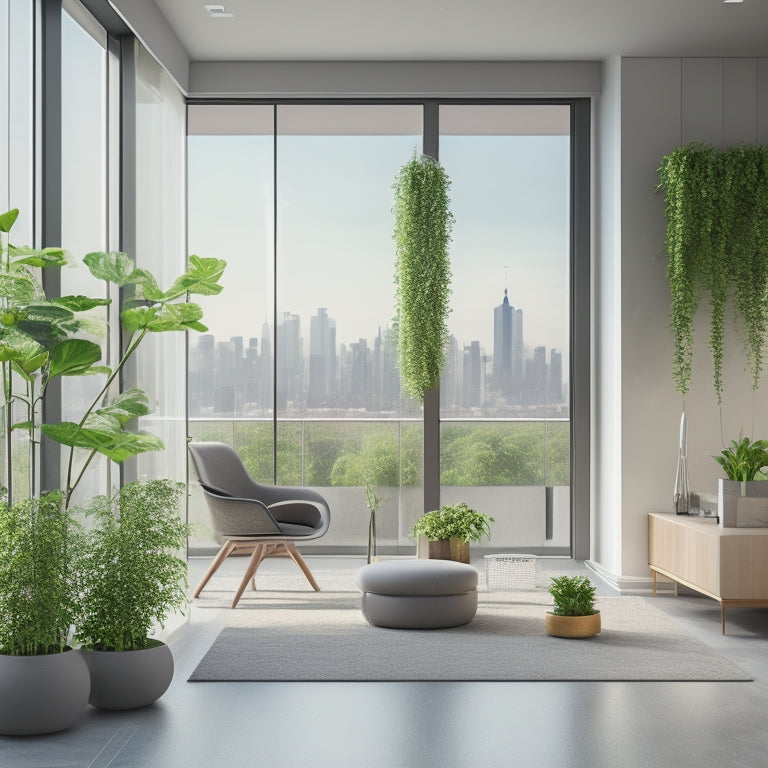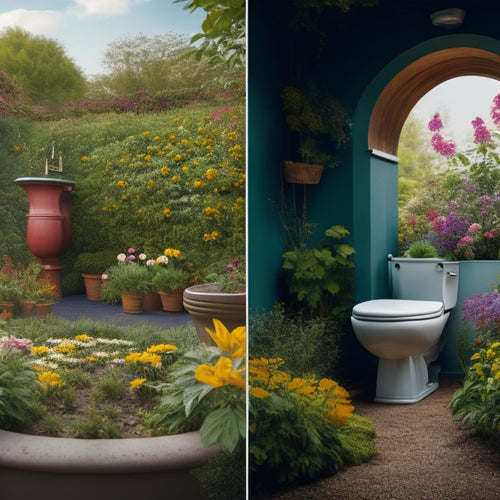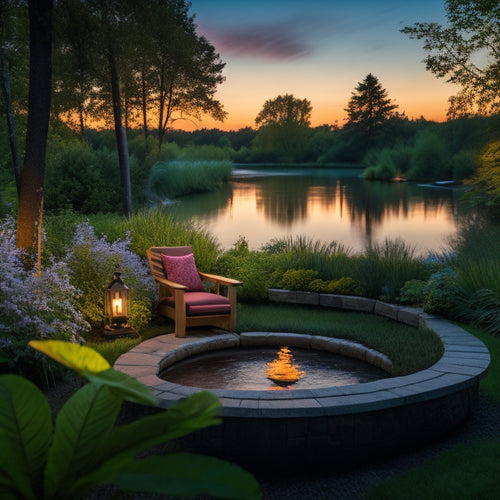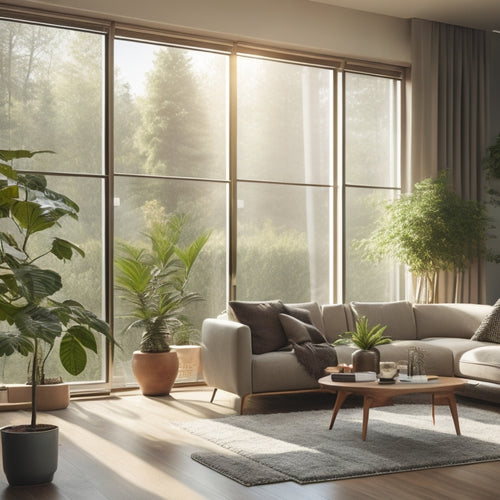
Space-Saving Hydroponic Systems for Urban Apartment Growers
Share
You're turning to hydroponic systems to maximize your yields in the limited space of your urban apartment, and you're looking for setups that will help you grow a bounty of fresh produce without sacrificing useful floor space. Compact hydroponic systems are designed specifically for small spaces, offering eco-friendly practices and vertically stacked layers for efficient growth. Top brands like General Hydroponics, Hydrofarm, and Bright Agrotech provide innovative solutions customized to urban growers' needs. By understanding the benefits of vertical gardening, choosing the right hydroponic kit, and considering DIY options, you'll be well on your way to harvesting fresh produce in your apartment - and there's more to investigate to optimize your growing experience.
Key Takeaways
- Compact hydroponic systems from brands like Hydrofarm and Bright Agrotech cater specifically to urban growers with limited space.
- Vertical gardening and trellised systems maximize yields while minimizing footprint, making them ideal for urban apartment growers.
- Consider DIY hydroponic system options using recycled materials to reduce costs and environmental impact in small spaces.
- Choose beginner-friendly hydroponic kits with small system sizes (2x2 ft) to accommodate 4-6 plants, perfect for urban apartments.
- Implement tiered or wall-mounted setups to increase growing capacity without sacrificing floor space, maximizing yield in limited spaces.
Hydroponic Systems for Small Spaces
Optimizing your growing space is essential when working with limited areas, and hydroponic systems for small spaces offer a solution by maximizing yields while minimizing footprint.
You can create compact setups that thrive in urban agriculture environments, where space is scarce. Additionally, incorporating eco-friendly practices, such as renewable energy sources, can further reduce your carbon footprint.
Hydroponic systems for small spaces are designed to be efficient, using vertically stacked layers or trellises to make the most of your available area. This allows you to grow a variety of crops in a fraction of the space required by traditional soil-based methods.
Benefits of Vertical Gardening
By adopting hydroponic systems for small spaces, you've already taken a significant step towards maximizing your yields in limited areas.
Now, let's examine the benefits of vertical gardening, a key aspect of urban agriculture. By utilizing vertical space, you can grow a wide variety of plant species using advanced growing techniques. This approach not only increases yields but also adds aesthetic appeal to your urban oasis.
Moreover, integrating fast charging infrastructure in urban areas can enhance convenience and user experience, much like how vertical gardening enhances food security and community building.
In addition, both concepts prioritize sustainability and reduced environmental impact. Vertical gardening also offers environmental benefits, such as improved air quality and reduced pest management issues.
It encourages community gardening and enhances food security, allowing you to enjoy fresh produce right in your apartment.
Choosing the Right Hydroponic Kit
When selecting a hydroponic kit for your space-saving system, you'll need to take into account the type of kit that best fits your needs, whether it's an NFT, DWC, or Ebb and Flow system.
You'll also need to think about the size of the system, as it'll impact the number of plants you can grow and the space required.
Additionally, it's crucial to take into account the durability and longevity of the system, with a minimum service life of 25 years, similar to high-efficiency solar panels, to guarantee a long-term and sustainable growing experience.
Kit Types Available
Investigate the diverse range of hydroponic kits on the market to find the perfect fit for your space and growing needs.
You'll find various hydroponic kit types catering to different levels of knowledge and space constraints. As a beginner, you'll appreciate these beginner-friendly options:
With the increasing adoption of electric and hybrid vehicles in fleets, it's crucial to evaluate the role of renewable energy in sustainable urban living renewable energy solutions.
Additionally, incorporating green hydrogen fuel cells can provide a zero-emission propulsion with fewer moving parts and lower maintenance costs.
-
Starter Kits: Ideal for small spaces, these kits usually include a compact grow chamber, nutrients, and a pump.
-
Indoor Herb Gardens: Perfect for growing a selection of herbs, these kits often feature a compact, self-watering design.
-
DWC (Deep Water Culture) Kits: Suitable for larger plants, these kits use a reservoir to supply nutrients to the roots.
- Ebb and Flow Kits: These kits use a timed pump to flood and drain the grow chamber, providing plants with a consistent supply of nutrients.
Hydroponic System Size
With your growing needs and available space in mind, it's essential to determine the ideal hydroponic system size to guarantee a successful harvest. You'll want to evaluate the system dimensions, compact setups, and the number of plants you plan to grow.
| System Size | Recommended Space | Plant Capacity |
|---|---|---|
| Small | 2x2 ft | 4-6 plants |
| Medium | 3x3 ft | 8-12 plants |
| Large | 4x4 ft | 16-20 plants |
| Extra Large | 5x5 ft | 24-30 plants |
| Commercial | 10x10 ft | 50-60 plants |
Choose a system that fits your available space, and don't forget to leave room for air circulation and access for maintenance.
DIY Hydroponic System Options
You can create a customized hydroponic system that fits your space constraints by building your own kit from scratch.
Consider repurposing recycled materials to reduce waste and save money on equipment costs, similar to the cost-effective approach of solar panel recycling, which can cost between $20-$30 per panel.
Build Your Own Kit
Several DIY hydroponic system options are available for those looking to build their own kit, catering to varying levels of skill and resource availability.
You can choose from a range of DIY hydroponic systems that suit your needs, from simple to complex setups.
You'll need to select the necessary hydroponic equipment, such as pumps, tubes, and reservoirs, and decide on a suitable nutrient solution for your plants.
Consider the following components:
- Reservoir: holds the nutrient solution
- Pump: circulates the solution to the plants
- Grow chamber: where the plants receive the solution
- Nutrient solution: provides essential nutrients for plant growth
Recycled Materials Ideas
Getting creative with recycled materials can considerably reduce the costs and environmental impact of your DIY hydroponic system. You can repurpose old plastic bottles, cardboard tubes, or wooden crates as upcycled containers for your plants.
These creative planters not only reduce waste but also provide a budget-friendly solution for your hydroponic setup. Look for sustainable materials like reclaimed wood, bamboo, or recycled plastic to build your system.
Innovative designs can be achieved with minimal materials, making your eco-friendly system a true reflection of your commitment to the environment. By using repurposed items, you'll reduce your carbon footprint and create a unique, space-saving hydroponic system that's both functional and visually appealing.
Space-Saving Designs
Compact hydroponic systems can thrive in small spaces, making them ideal for urban dwellers, balconies, or rooftops.
You can create your own compact solutions using modular designs that maximize space. These systems are perfect for small-scale growing and can be easily assembled and disassembled.
Consider the following DIY hydroponic system options:
- Vertical gardens: Use a trellis or wall-mounted system to grow plants upwards, saving floor space.
- Window-mounted planters: Attach planters to your windowsill, utilizing natural light and minimizing floor space.
- Modular containers: Use stackable containers to grow multiple plants in a small footprint.
- Microgreens systems: Grow microgreens on a small, space-efficient tray, perfect for indoor growing.
These designs offer you the freedom to grow your own food, even in the smallest of spaces.
Top Brands for Apartment Growers
Your space-saving hydroponic setup is only as good as the brand behind it. When choosing a brand, consider factors like product quality, customer support, and warranty.
Top brands for apartment growers include General Hydroponics, Hydrofarm, and Bright Agrotech. General Hydroponics offers a wide range of hydroponic systems, while Hydrofarm provides affordable and compact options.
Bright Agrotech is known for its innovative LED grow lights. Research brand comparisons and product reviews to find the best fit for your needs.
Look for brands that cater to urban growers, offering compact and energy-efficient systems. By investing in a reputable brand, you'll guarantee a successful and stress-free growing experience.
Hydroponic System Maintenance Tips
Regular system checks and timely maintenance are essential to preventing hydroponic system failures, which can be disastrous for your crop.
You'll want to stay on top of your system's performance to guarantee ideal growing conditions.
Here's what you should do:
-
Monitor pH balance: Check the pH level of your nutrient solution daily to guarantee it's within the ideal range for your plants.
-
Check nutrient solution levels: Regularly inspect the reservoir to guarantee the nutrient solution is at the recommended level.
-
Inspect pumps and tubing: Look for signs of wear or damage that could lead to system failures.
- Clean the system: Regularly clean the system to prevent buildup and maintain healthy plant growth.
Maximizing Yield in Small Areas
By maintaining a well-functioning hydroponic system, you're already on the path to achieving a bountiful harvest.
To maximize yield in small areas, focus on compact gardening techniques and efficient layouts. This means selecting varieties that thrive in vertical or trellised systems, allowing you to make the most of your space.
Consider using a tiered or wall-mounted setup to increase growing capacity without sacrificing floor space. Additionally, implement a pruning strategy to encourage bushy growth and prevent overcrowding.
Frequently Asked Questions
Can I Grow Hydroponic Plants in a Room With Low Light?
You think low light means no hydroponic gardening, but you're wrong! You can grow low-light plants like lettuce and herbs using LED grow lights or placing them near windows, making indoor gardening a possibility in even the darkest rooms.
Are Hydroponic Systems Compatible With Apartment Water Pressure?
You'll be relieved to know that most hydroponic systems are designed to work with standard apartment water pressure, typically between 30-80 psi, making them compatible with your apartment setup.
Do Hydroponic Plants Require More Water Than Soil-Based Plants?
As you immerse yourself in the world of hydroponics, you'll find that these plants don't necessarily guzzle more water; in fact, they can be more water-efficient, thanks to precise nutrient absorption, allowing you to cultivate with freedom and minimize waste.
Can I Use a Hydroponic System to Grow Root Vegetables?
You can grow various root vegetable varieties hydroponically, but you'll need to contemplate hydroponic root depth, as some veggies require deeper systems; for example, carrots and beets need more depth than radishes and turnips, so plan your system accordingly.
Are Hydroponic Systems Safe for Households With Pets?
You guarantee pet safety by keeping curious critters away from hydroponic systems, and maintaining a clean setup reduces pet-accessible toxic substances, allowing you to grow worry-free while your furry friends roam freely.
Related Posts
-

Why Transform Human Waste Into Garden Gold?
By changing human waste into garden gold, you'll reduce waste management costs, support sustainable agriculture, and ...
-

Transform Your Outdoor Space With Recycled Plastic Lumber
By incorporating recycled plastic lumber into your outdoor design, you're not just building a deck or installing a fe...
-

3 Eco-Friendly Automated Blinds for Contemporary Living
You're looking to raise your living space with automated blinds that not only exude contemporary style but also align...


